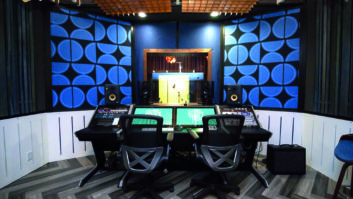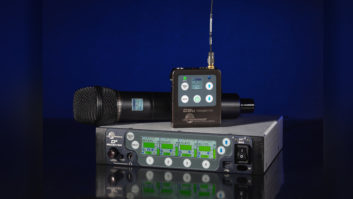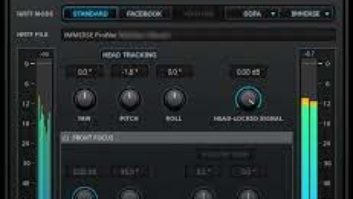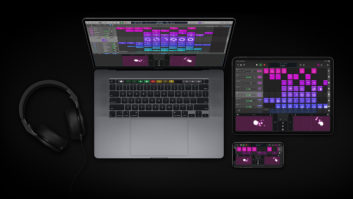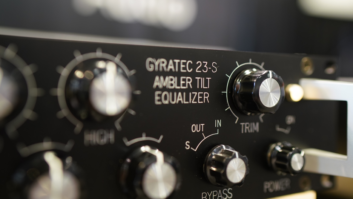EIGHT-CHANNEL MIC PREOne of the most important links in the recording chain is the microphone preamplifier, and many engineers recognize that console preamps can often be bettered. And the popularity of 8-track digital recorders has created a market for mic pre’s that interface directly with MDMs, bypassing a console entirely. Marketed by Neumann USA, the Precision 8 is an eight-channel microphone preamp manufactured by True Systems, a product line of Tucson, Ariz.-based Sunrise Engineering and Design, Inc.
In order to fit eight mic pre’s into a single rackspace, Sunrise Engineering has eliminated some of the bells and whistles common to other 8-channel preamps, such as a summed output, a headphone amp or aux sends. However, the Precision 8 offers a few handy features not found on other units: The first two channels can function as an M/S decoder, and the last two channels double as instrument direct boxes. The metering scheme is well thought-out with peak hold and reset functions, as well as an adjustable peak reference level.
APPEARANCEThe sturdy enclosure has a thick front panel with nine knobs: eight for input gain and one for selecting peak reference. The peak selector knob is a stepped switch, while the gains are continuously variable. Every gain knob is flanked by switches for polarity reverse and 48V phantom power. An additional switch engages the M/S decoder on the direct outputs of channels one and two. The switches feel solid, and the knobs have a satisfying smoothness when turned. White lettering on a burgundy background is easy enough to read, even in dimly lit environments and adds to the handsome appearance of the unit.
Each channel has its own overload light and five-segment level meter. On each meter, the first two green segments indicate signal present (anything exceeding -24dBu) and the second lights up at +4dBu. The next two segments are yellow and show when the signal is 6 dB and 3 dB below the level set by the peak reference switch. The red fifth segment illuminates when the selected peak reference is reached. The peak and overload LEDs remain lit once illuminated; the Reset button clears all held peaks.
The back panel has eight XLR inputs (the DI inputs for channels seven and eight are Neutrik Combo XLR/11/44-inch jacks). Sixteen outputs allow the Precision 8 to function as a splitter, with eight of the outputs appearing on balanced 11/44-inch jacks, and the other eight outputs available through one DB25 (multipin) connector wired to the Tascam convention. The rear panel also has a ground lift switch.
CONTENTSThe instrument DIs are discrete FET designs, while the mic preamp is a hybrid design which uses discrete, monolithic, dual bipolar transistors for the input stage, followed by Burr-Brown IC op amps for the intermediate stage and output driver. No transformers are employed, and there are almost no capacitors (two are used for phantom power blocking). The result is an extremely flat, uncolored signal.
Metering options are numerous. Resetting eight-internal jumpers (one for each channel) switches the yellow -3 and -6 indicators to operate in peak-hold mode.
The signal path of the M/S decoder is simple, using no extra buffering or phase inversion circuitry. Both phases of channel one and channel two signals are already available internally and are combined resistively at the intermediate stages of the two channels. This causes the gain controls of the two channels to interact when decoding M/S. For example, changing the width also changes the output level, but I had no trouble achieving the desired stereo image with proper output.
The stated specifications are impressive: Frequency response at 40dB of gain is 1 to 500k Hz, +0/-3dB, noise is rated at -132 dB EIN (20 to 30k Hz) and maximum output is +31dBu.
IN USEI tried the Precision 8 on voice, acoustic guitar, drum overheads and percussion, and each time met with astonishing results. It’s a shame that my DAT and MDMs only record at 48 kHz, because they’re missing some of the glorious top end provided by these fine preamps. My AKG 414s sounded better than ever; I heard exactly what they picked up, with no noticeable coloration of the sound. I compared the unit to a few other solid state preamps, and, in terms of clarity, presence and absence of noise, the Precision 8 won every shoot-out.
When I set up an M/S pair for the drums, I chose to record the Mid and Side channels straight – undecoded by the P 8 – to two tracks. The P 8 allows one to record a decoded M/S image to two tracks (via the direct outs of channels one and two), but I chose to do the decoding in the mix with three channels of the console. This allows one to change the width of the stereo picture at a later date. But I used the preamp’s internal decoder to check the M/S pair for alignment during set up and found it quite the luxury.
The DI channels also came in handy on some live to ADAT sessions. Samplers, drum machines and synthesizers all sounded perfect, driven by the Precision 8 down a long snake.
CLEAN, CLEAN, CLEANWith its compact size, splitting capability, peak hold metering and transparent sound quality, the Precision 8 is ideal for location recording. It does get fairly hot after being powered up for an hour, but proper ventilation should take care of that.
This is one of the cleanest preamps I have ever heard, only adding discernable noise after 45 dB of gain. Even if you are looking for a tube preamp to warm up your digital recordings, you might want to hear one of the best preamps the solid state realm can offer. Sold separately, eight preamps, two DIs and an M/S decoder might run as high as $5,000, but True Systems’ suggested retail price for the Precision 8 is $2,695.

